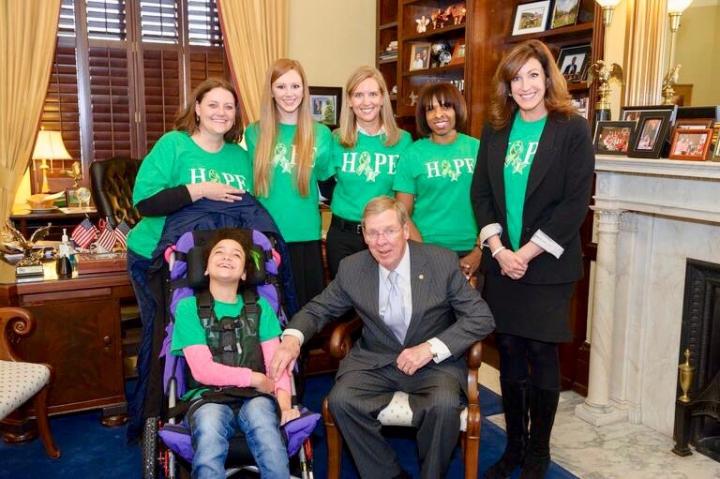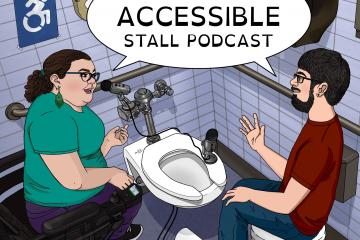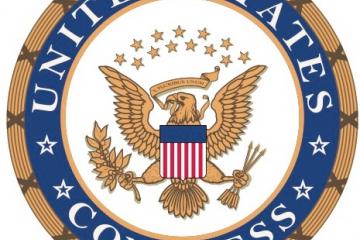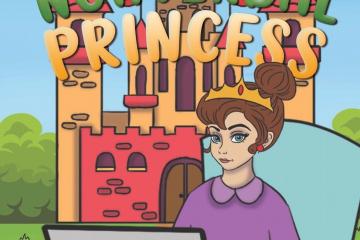The History of Research Advocacy in Cerebral Palsy

Cerebral palsy advocacy - where we’ve been, where we are currently, and the opportunities that are ahead.
Since 2005, the cerebral palsy community has increased its focus on the need for federally funded cerebral palsy research. The community has come together to advocate for answers to so many basic questions about cerebral palsy, which is a critical public health issue and the most common lifelong motor disability impacting more than 1 million Americans and 17 million people worldwide as well as their families.
Federal investment in cerebral palsy research in the United States (US) has long been underfunded, and under-prioritized, despite the number of Americans impacted. In fact, until 2004 there were no organized community-based advocacy efforts focused on increasing federal cerebral palsy research investment. It took a few years more before clinicians and stakeholders collaborated and worked hand-in-hand to advocate for change.
Advocacy and dedication to a greater social good is an essential element of professionalism for all health care practitioners and is part of the moral duty of belonging to that community.
The American Medical Association (AMA) mandates that the members of the world community of physicians “advocate for the social, economic, educational, and political changes that ameliorate suffering and contribute to human well-being.” (AMA Declaration of Professional Responsibility). According to the American Physical Therapy Association, "there are seven core values that comprise professionalism in physical therapy”; among them are social responsibility and altruism. The American Occupational Therapy Association’s (AOTA) seven core values include Altruism and Justice.
Provision 3 of the American Nurses Association (ANA) code of ethics states: “The nurse promotes, advocates for, and protects the rights, health, and safety of the patient”, and the Accreditation Council for Graduate Medical Education (ACGME) Pediatrics Residency Review Committee now requires advocacy training and experience for all pediatric residents.
These professional virtues are an essential part of the social contract that health professionals share with their patients and are no small obligation. There are stark examples throughout history when this commitment has waned among health professionals, and often the moral fiber of the society follows. Consider the role of doctors, nurses, and other trusted caregivers in the Tuskegee experiments, Nazi Germany, prison experimentation and patients in mental institutions as recently as the 1970s.
The American Academy for Cerebral Palsy and Developmental Medicine (AACPDM) is a professional society dedicated to providing multidisciplinary scientific education and promoting excellence in research and services for the benefit of people with and at risk for cerebral palsy and other childhood-onset disabilities.
The Committee’s mission was “to inform and educate AACPDM membership to be effective advocates for research, healthcare and related issues important to both professionals and families of children with cerebral palsy and other developmental disabilities”. A key goal was to collaborate with organizations that shared this mission in an effort to advocate more effectively - both nationally and internationally.
The AACPDM Committee would soon learn that a group of committed parents were far ahead of its advocacy efforts, and had paved the way for a strong collaboration.
Parent and family leadership is not unusual in the world of research advocacy for children with disabilities. In fact, strong parent/professional partnership has been the bedrock of progress for many health conditions including cerebral palsy. In the 1940s, a group of parents of children with cerebral palsy founded the non-profit organization, United Cerebral Palsy (UCP). They soon went on to establish a professional partnership with several physicians and scientists by reaching out to Dr. Sidney Farber who brought 14 top medical scientists together to form the United Cerebral Palsy Research and Educational Foundation. In 2016 this nonprofit foundation was renamed the Cerebral Palsy Foundation (CPF).
Because of this strong parent/professional partnership, the United Cerebral Palsy Research and Educational Foundation grew into America’s principal non-governmental, nonprofit organization funding research in the 1990s and early 2000s directly related to cerebral palsy and improvement in the quality of life of persons with disabilities due to cerebral palsy and related developmental brain disorders. These efforts paved the way for a new era of powerful family advocacy to increase national awareness of the public health need for more cerebral palsy research funding and focus.
As a result, the collaboration between stakeholder advocacy groups and professional medical societies has been extremely effective in bringing more attention to cerebral palsy research priorities among policy makers.
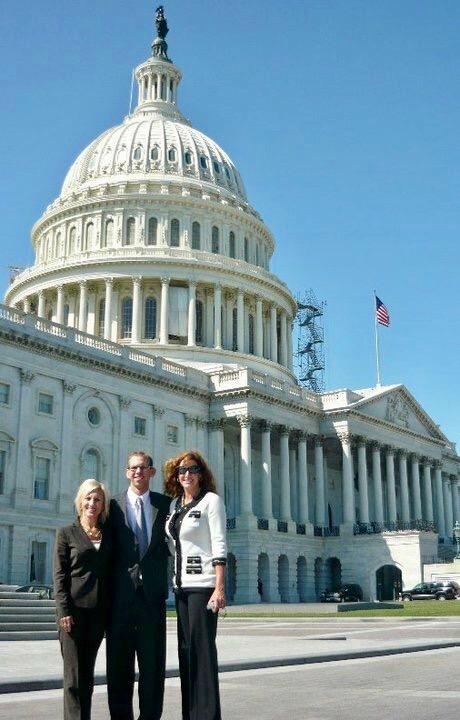
Here follows a brief timeline of advocacy milestones for increased cerebral palsy research investment and federal focus.
2005
In 2005, the AACPDM was introduced to Reaching for the Stars: A Foundation of Hope for Children with Cerebral Palsy (RFTS), which had grown into one of the largest, global nonprofit organization led by parent volunteers. RFTS was co-founded by Cynthia Frisina and Anna Marie Champion, two mothers of young daughters with cerebral palsy who were committed to increasing US cerebral palsy research funding, family education and improved treatment options serving the needs of children with cerebral palsy and their families. RFTS merged with the Cerebral Palsy Foundation in 2019.
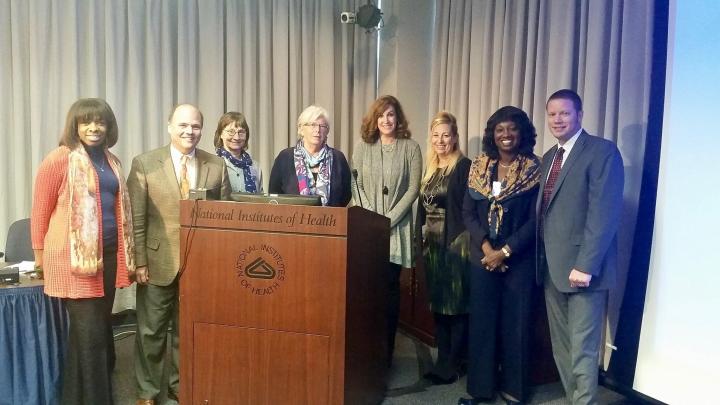
2006
In 2006 the AACPDM Board of Directors formally recognized its commitment to help advance US federal funding for cerebral palsy research and in doing so paved the way for the development of a strong and effective parent/professional partnership between the AACPDM and RFTS. Other organizations would follow in support beginning in 2015 as part of a collaborative effort between cerebral palsy organizations and stakeholders to advance a national research agenda, including the Cerebral Palsy Foundation, Cerebral Palsy Research Network (CPRN), UCP, Cerebral Palsy Alliance, CPNOW, American Academy of Physical Medicine and Rehabilitation, and the Academy of Pediatric Physical Therapy.
A primary issue hindering progress was the fact that there was no dedicated federal funding in the US national budget specifically earmarked for cerebral palsy research despite the number of people impacted. Clearly, research funding was out of alignment with prevalence of this condition identified in 1 in 345 American children every year (https://www.cdc.gov/ncbddd/cp/data.html). Stronger advocacy efforts were needed to convince lawmakers that federal investment into cerebral palsy prevention, causation, treatment, and the possible cure of some types of cerebral palsy was vital. RFTS noted that rarer conditions affecting far fewer people have continued to be funded as priority areas in the US Congressional Budget.
In order to elevate cerebral palsy awareness in Congress, significant, organized stakeholder/clinician advocacy efforts led to Congresswoman Joanne Emerson (MO) and Chairman Ralph Regula (OH) inviting RFTS to testify before the US House Appropriations Subcommittee regarding the critical funding need for cerebral palsy surveillance and increased National Institutes of Health (NIH) research. Pediatric neurologist Dr. Jan Brunstrom and RFTS co-founder Cynthia Frisina traveled to Washington, D.C., to present testimony. Additionally, RFTS secured letters of support from several other related organizations at that time, including Easter Seals, March of Dimes, Child Neurology Society, and the AACPDM. These letters of support were valuable in showing that the movement had widespread support among partner organizations and stakeholders. As a result, Congresswoman Emerson became a supporter of early cerebral palsy research advocacy efforts which led to the inclusion of initial Congressional report language identifying the federal need for cerebral palsy research focus in 2008. US Congressional Report language refers to information provided in reports accompanying House or Senate committee- reported legislation, as well as joint explanatory statements, which are included in conference reports. Report language contains more detailed guidance to US government departments and agencies than is provided in related appropriations bills or legislative text in conference reports.
In that same year, RFTS established National Cerebral Palsy Awareness Day (March 25th) with the support of Senators Johnny Isakson (GA) and Robert Casey (PA) to bring attention to the lack of dedicated federal research funding for cerebral palsy. The color green was chosen to represent the day and has grown into the global color for cerebral palsy awareness.
2008
As a result of strong stakeholder advocacy efforts, the Senate Appropriations Committee (led by Senator Richard Durbin [IL]) included “appropriations report language” requesting data from the Centers for Disease Control and Prevention (CDC) regarding cerebral palsy data and statistics within the FY 2008 Labor, Health and Human Services, and Education Appropriations bill. Appropriations are annual decisions made by Congress about how the federal government spends some of its money.
Here is an excerpt from that bill:
“The Committee requests a report by July 31, 2008 on what types of data are most needed for a public health response to cerebral palsy and the strengths and weaknesses of the various methods of collecting epidemiologic data in this population. As part of tthat report, the Committee encourages the CDC to consider establishing cerebral palsy surveillance and epidemiology systems that would work in concert with similar disorders.”
In its response to Congress, the CDC reported that cerebral palsy is the most common motor disability in the US, affecting more than 800,000 children, adolescents and adults in America. The report went on to explain that the prevalence of cerebral palsy is higher than originally thought and by adding additional funding for cerebral palsy to the existing CDC developmental disabilities infrastructure the root causes, and possible prevention, of cerebral palsy can begin to be discovered.
These Congressional requests and responses may seem simple, but they marked the first time that key governmental agencies had been required to report on cerebral palsy. It was an important inflection point in the cerebral palsy advocacy journey.
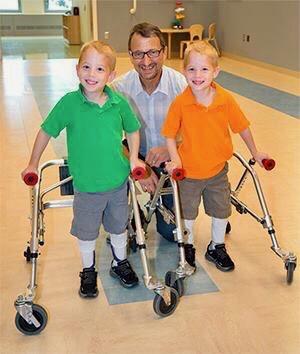
2010
The AACPDM Annual Meeting was held in Washington, D.C., and 25 Academy members and family stakeholders “Headed for the Hill” as a group to visit with lawmakers and raise awareness about cerebral palsy and the critical need for more funding. Before the visit, participants were prepped by the American Academy of Pediatrics Department of Federal Affairs at a well-attended advocacy training event.
2011
February
Parents and professionals made a Capitol Hill visit organized by RFTS and AACPDM.
Four primary goals were achieved:
1. To communicate the cerebral palsy community policy agenda of $10 million for cerebral palsy research and surveillance.
2. To continue to educate and develop relationships with lawmakers.
3. To meet with the Office of Management and Budget to discuss policy priorities.
4. To continue to educate stakeholder organizations about the funding process in Washington, and how to work towards the ultimate goal of advancing research for cerebral palsy.
December
As a follow up step, RFTS and key AACPDM clinicians were invited to a meeting at the CDC National Center on Birth Defects and Developmental Disabilities (NCBDDD) to discuss next steps, in addition to a meeting with the National Institutes of Health (NIH).

2012
RFTS organized a large stakeholder/physician group to visit Washington, D.C. This group included parents Cynthia Frisina and Wendy Sullivan, as well as Michael Kutcher, a cerebral palsy advocate and an adult with lived experience. Additionally, doctors Lisa Thornton, Joe Dutkowsky, Jeri Beth Karkos, Jane Ann Emerson, and Dennis Hart attended. The group met with several members of Congress. Kutcher is a native Iowan and constituent of Senator Tom Harkin (IA), then Chairman of the Senate Appropriations Committee. Senator Harkin, a longtime supporter of people with disabilities, met with the group personally. In 1990 he introduced the American with Disabilities Act and delivered part of his speech in sign language so that his deaf brother could understand. Additionally, the group interacted with key staffers in other Congressional offices.
With such strong collaboration and support, the mission of the group was to encourage Senator Harkin, and other policymakers, to support cerebral palsy research funding. As an influential member of the Senate Appropriations Committee, Senator Harkin also chaired the Senate Subcommittee on Health, Education, Labor, and Pensions. The AACPDM physician/parent coalition focused both on Senator Harkin and now-deceased Georgia Senator Johnny Isakson, Frisina’s senator who was also a significant supporter of people with cerebral palsy and the continued Congressional champion of National Cerebral Palsy Awareness Day.
The relationships established with key policymakers, the initiation of the AACPDM Advocacy Committee, and the coordination with stakeholder groups, cerebral palsy nonprofits, individual patients and professionals all came together to the betterment of patients and families with cerebral palsy.
2013
Advocacy visits to Capitol Hill and the NIH continued to emphasize the importance of cerebral palsy research and relevant Appropriations report language.
2014
March
Cynthia Frisina (RFTS) was invited to testify before the Labor, Health and Human Services (LHHS) House Subcommittee on Appropriations and invited Dr. Thornton to join her as a clinician. Together, along with other parents including Wendy Sullivan, Brad Searle and Patty Lyons, they effectively communicated the benefit of a strong parent/physician advocacy partnership to various lawmakers. The full text of their Public Witness Testimony can be found here:
https://docs.house.gov/meetings/AP/AP07/20140325/101877/HHRG-113-AP07-Wstate-
Also in 2014, RFTS expanded National Cerebral Palsy Awareness Day to include a green ribbon and the hashtag #GoGreen4CP campaign that included lighting up buildings green across the US. Families, stakeholders and healthcare providers across America embraced the idea and began engaging communities to participate in a variety of ways.
Additionally, a collaborative stakeholder group drafted LHHS appropriations language calling for dedicated cerebral palsy funding and the creation of a five-year US Cerebral Palsy Strategic Plan, a historic first.
This also led to the creation of the Cerebral Palsy Collaborative, initiated by parent advocate Jennifer Lyman, whose purpose was to unite cerebral palsy nonprofit stakeholders and professional nonprofit organizations to support important advocacy initiatives. The original organizations who were a part of the Cerebral Palsy Collaborative included RFTS, the Cerebral Palsy Foundation, AACPDM, the Cerebral Palsy Research Network, United Cerebral Palsy, CP Now and Cure CP.
Additionally, over 7000 people signed a petition in 2014 circulated on Change.org to show support for the proposed appropriations language and the public health need for cerebral palsy research. In May of 2014, stakeholders, clinicians and researchers met at the NIH for the State of the Science workshop to discuss the NIH Cerebral Palsy Strategic Plan and priorities.

2014
March
Cynthia Frisina (RFTS) was invited to testify before the Labor, Health and Human Services (LHHS) House Subcommittee on Appropriations and invited Dr. Thornton to join her as a clinician. Together, along with other parents including Wendy Sullivan, Brad Searle and Patty Lyons, they effectively communicated the benefit of a strong parent/physician advocacy partnership to various lawmakers. The full text of their Public Witness Testimony can be found here:
https://docs.house.gov/meetings/AP/AP07/20140325/101877/HHRG-113-AP07-Wstate-
Also in 2014, RFTS expanded National Cerebral Palsy Awareness Day to include a green ribbon and the hashtag #GoGreen4CP campaign that included lighting up buildings green across the US. Families, stakeholders and healthcare providers across America embraced the idea and began engaging communities to participate in a variety of ways.Additionally, a collaborative stakeholder group drafted LHHS appropriations language calling for dedicated cerebral palsy funding and the creation of a five-year US Cerebral Palsy Strategic Plan, a historic first.
This also led to the creation of the Cerebral Palsy Collaborative, initiated byparent advocate Jennifer Lyman, whose purpose was to unite cerebral palsy nonprofit stakeholders and professional nonprofit organizations to support important advocacy initiatives. The original organizations who were a part of the Cerebral Palsy Collaborative included RFTS, the Cerebral Palsy Foundation, AACPDM, the Cerebral Palsy Research Network, United Cerebral Palsy, CP Now and Cure CP.
Additionally, over 7000 people signed a petition in 2014 circulated on Change.org to show support for the proposed appropriations language and the public health need for cerebral palsy research. In May of 2014, stakeholders, clinicians and researchers met at the NIH for the State of the Science workshop to discuss the NIH Cerebral Palsy Strategic Plan and priorities.
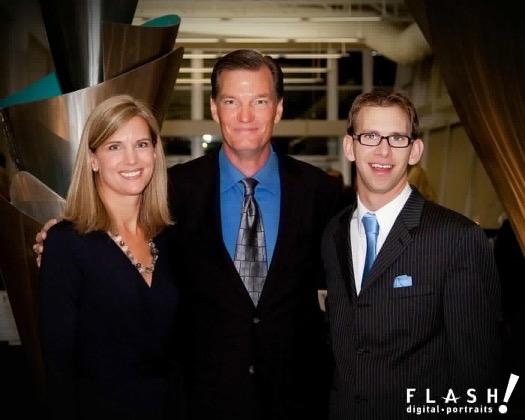
2015
RFTS and a collaborative group of cerebral palsy stakeholders continued to be successful in securing cerebral palsy appropriations language into the Senate Labor, Health, and Human Services and Education (LHHSE) Appropriations Bill. The cerebral palsy appropriations language did not yet have specific funding included; however, it did have the expectation of important deliverables from the CDC and NIH that increased federal focus and research opportunities for cerebral palsy marking another step forward.
2017
In 2017, the Congressional Appropriations report language developed pursuant to these efforts was indeed incorporated into the creation of the first National Cerebral Palsy Strategic Plan, formally recognizing the need, and paving the way for increased funding, for cerebral palsy and related research priorities outlined in 2014. Several CP organizations and individuals were significantly involved in this effort including Paul Gross with the Cerebral Palsy Research Network, the AACPDM and the Cerebral Palsy Foundation.
2018-2021
Advocacy visits to Capitol Hill and the NIH in 2018 and 2019 continued to keep the cerebral palsy research agenda at the forefront for policymakers. In 2020 and 2021, those visits became virtual in light of Covid-19.
Over the years collaborative partnerships have continued to expand as professional and stakeholders organizations increasingly recognize the importance of federal advocacy and embrace the agenda for increased funding for cerebral palsy research.
In 2019, RFTS merged with the Cerebral Palsy Foundation, increasing impact and ability to educate policymakers. The website www.gogreen4cp.org was developed to inform the public, stakeholders, families, clinicians and lawmakers regarding cerebral palsy research priorities and also educate the community regarding how to effectively communicate with their lawmakers.
Legislative efforts in 2020 and 2021 have resulted in the strongest Congressional focus on cerebral palsy research funding in history and are leading towards the second National Cerebral Palsy Strategic Planning Workshop to be held in 2022 or 2023 at the NIH.
2022
The Cerebral Palsy Foundation is hosting the first Cerebral Palsy Congressional briefing on March 24th in recognition of National Cerebral Palsy Awareness Month with the support of Senator Maggie Hassan (NH) and Congressman Steve Cohen (TN) highlighting patient and parent advocates, researchers and clinicians speaking on the need for federal investment for cerebral palsy research. Additionally, the CP Collaborative is supporting two new legislative bills that include cerebral palsy, as well as updated Congressional Appropriations report language for FY 2023. These new legislative efforts will amplify for cerebral palsy specific research across the lifespan.
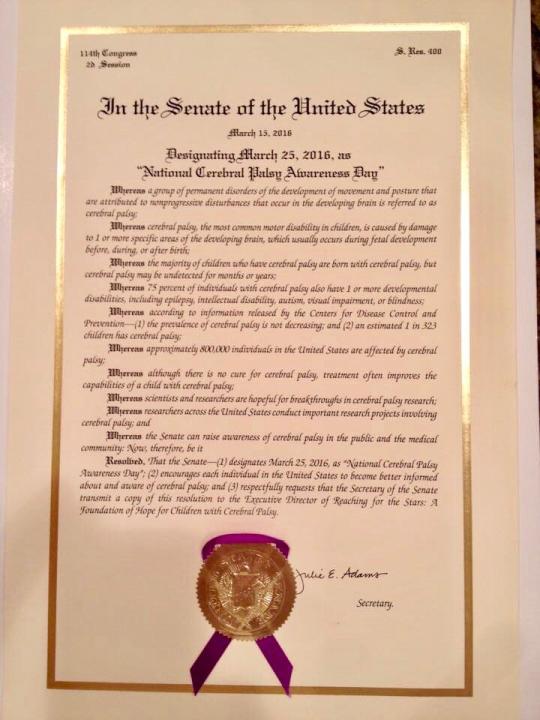
Lessons Learned
The success of the cerebral palsy advocacy journey to date can be attributed to a growing understanding of how to be effective in the unique political environment of the US Government. Here is a short list of lessons learned:
• Unifying stakeholder community members and organizations in collaboration (in this case cerebral palsy related) on federal legislative topics is vitally important for long term collective success.
• Legislative impact anchored with strong personal impact stories remind policymakers that their decisions and actions affect more than 1,000,000 Americans living with cerebral palsy and their families.
• We need to be patient, yet persistent. Legislative priorities and research agendas take time to be considered and adopted. In many cases, this takes years of sustained effort and commitment.
• Community support and collaboration among stakeholder groups and other organizations on core issues is important to creative positive change.
• It’s important to work towards consensus and broad support with policy makers, government agencies, cerebral palsy organizations, key stakeholders and the cerebral palsy community.
• It’s particularly helpful to encourage advocates who live in the areas that are represented by key policymakers to speak up.
• Congressional staff members are core in identifying priorities, and are often experts in their topic areas.
• Knowing the Congressional calendar is important so that efforts can timed effectively.
Conclusion
As advocates, health care professionals provide strong support for advancing the science of the profession and also improving the wellbeing of patients. To develop strong physician/stakeholder partnerships, a commitment to stakeholder priorities should be explicitly stated, clearly visible, and unwavering.
Families, stakeholders, and those directly impacted by cerebral palsy have a commitment and urgency that may not be as deeply held by others. Varying perspectives must be considered and included in the discussions that lead to the most effective strategy to create positive change.
When professional medical values and stakeholder/family expectations align, these partnerships become powerful reflections of a shared vision and provide an effective force for transformational change across the lifespan.
